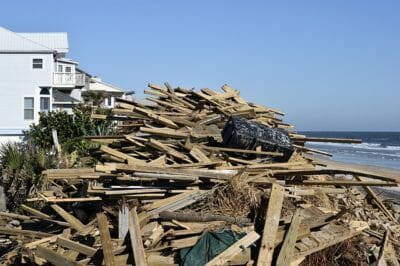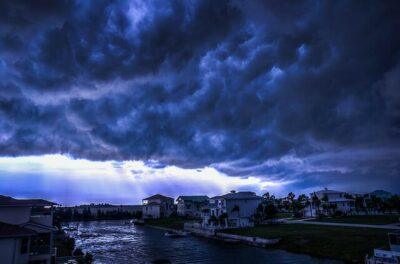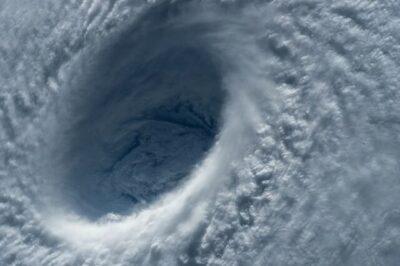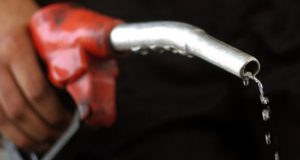The devastating power of nature is truly amazing. Our thoughts are with the east and west coast as they prepare for and deal with the devastation of hurricanes. It’s difficult to think that a single hurricane can cause billions of dollars of damage, undoing in mere days what has taken mankind years to build. The cleanup efforts for the damage that hurricanes cause will take an estimated three years or more.
Should You Bug Out?
The first question you must ask yourself when preparing for a hurricane is whether or not you should bug out. This depends a lot on where you live, the terrain around you, and the strength of the coming hurricane. There are many people on the east coast who won’t be affected by the hurricane, simply because their homes are just a few feet higher than the water.
If you don’t know how high you are above sea level, and how that compares to the area around you, then you need to get your hands on a topographical map. You can download these for free from the USGS website.
Finally, A Backup Generator That Doesn’t Require Gasoline!
If your home is located in what is known as a “100-year-flood zone,” chances are pretty good that you’ll be flooded out in any major hurricane. This term means that there is a one percent chance that your home will flood in any one year. Other zones are listed as “500-year flood zones” or “1,000-year flood zones.” Anyone who buys their home with a mortgage loan and who lives in a 100-year flood zone will be required to buy flood insurance as part of their contract. Few of the rest of us bother with that.
Just in Case

No matter what you do while preparing for a hurricane, there is nothing that prepares you for the devastation that follows.
Even if you are certain that you are living high and dry, where the flooding from the hurricane can’t get to you, you should be prepared to bug out. Hurricanes and tropical storms are unpredictable. Things might end up very different than you expect. Always make sure you leave yourself an avenue of escape.
To be specific, I mean that you should leave yourself an avenue of escape if there are five feet of water in your home. You don’t want to depend on being able to drive your car, unless you happen to have a monster truck parked in the driveway. Nor should you really count on walking. You won’t be able to see what’s under the water, so you might just step into a hole that’s 20-feet deep.
If you don’t happen to own a boat, you should probably invest in an inflatable rubber raft. You can buy these for as little as $100, giving yourself a means of getting to safety, instead of having to wait for someone to rescue you.
Don’t forget your bug-out bags. This is what they are for. If you don’t have one, it’s an ideal time to make one. Wherever you go when you bug out, you’ll need tools, equipment and supplies to help you survive.
What Do You Need to See You Through?
Even if you survive the hurricane in your home, you have to consider that you won’t have any electric power, water, sewage service and that your home may very well have several feet of water in it.
Often, preparing for a hurricane is really preparing to survive its aftermath. That means stockpiling the things you’ll need to have, until power is restored. Specifically, you’ll want:
- Bottled water
- Non-perishable food (canned food is great)
- Fuel (gasoline)
- A means of cooking your food
- Flashlights and batteries
- Battery operated radio
- Recharging battery for your phone
- Solar phone charger
- Good first-aid kit
- Toiletries, especially toilet paper
- Insect repellant
- Baby formula and diapers (if you have a baby)
- A complete set of important documents (identification, birth certificates, insurance, marriage license, property deeds, vehicle titles) in a waterproof container
- Laminated list of emergency phone numbers
- Cleaning supplies (for salvaging your home)
- Rain gear (ponchos and boots)
- Water purifier
All of this needs to be packed in waterproof containers, such as five-gallon buckets. Most storage bins aren’t waterproof, as the lids aren’t sealed. However, they will usually float, as long as things don’t get to the point where they are underwater.
Pocket Sized Solar Generator Provides Backup Power For Small Devices
Keep in mind that this list is just the most basic of supplies. If you are already a prepper, you probably already have much more than this. That’s good, because you’ll need it. Just make sure that if you have your prepping supplies stored in the basement, you move them to a higher point in your home when preparing for a hurricane.
Saving Your Home
Trying to save your home from a hurricane is difficult, at best. This boils down to two basic parts: keeping your home from being damaged by the wind and keeping the water out of your home.
There is little you can do to prevent your home from being damaged by high winds. Hopefully your home was already built with that in mind. Homes along the coast should be built with hurricane clips holding the rafters to the walls and other safeguards to protect them. But if you own an older home, it may not have some of these safeguards built in.
Other than direct damage to your home, the biggest risk that high wind creates for your home is breaking tree branches. If you have any tree branches that overhang your home’s roof, you should cut them off. You also should look around your home for loose objects that could become projectiles and store them away.
Flooding
But, as I already said, flooding is the bigger risk. Keeping water out of your home requires building a dam to stop the water. The most common way of doing this is with sandbags. These work well, because the sand moves, allowing the bags to seal well against one another. A properly built sandbag wall should be at least a few feet away from your home’s walls, so that you can walk around your home to check for leaks. You also will need a pump or two, to send any water that leaks through back over your sandbag wall.
But it takes a lot of sand and a lot of sandbags to make a wall around your home. Typically, a 10-foot-long section of four-foot-high sandbag wall requires about 160 sandbags, plus the sand to fill them. You will need a pretty good crew, working together, to fill all those bags and build the wall.
Another option is to buy water dams. There are a few different brands of these on the market. Basically, they consist of a flexible plastic tube, three or four feet across. Filled with water, they actually work better at creating a barrier than sandbags do, with less of a chance of spaces where water can leak through. They are also easier to set up, as you only need to lay them out and connect a hose. But you’ll need a lot of time for your hose to fill that many tubes.
During the Storm
If you find yourself trapped at home with the waters rising, don’t panic. Your home may have a second story, move up there. If not, you can move onto the roof. But whatever you do, don’t go into the attic to escape flood waters. An attic can become a death trap in these situations.
There actually was a home in the Houston area, during Harvey, where the homeowners pitched a couple of tents on their roof and sat the storm out in them. While not a normal method of protecting yourself from a hurricane, that was quite effective.
Chances are, someone will come by with a boat to rescue you if you end up on your home’s roof. But you’re better off being able to rescue yourself. That’s why I recommended buying a rubber raft. While that may not be as nice as having a speedboat to make your getaway in, it will still be effective.
What would you add to our list of hurricane preps? Share your tips in the section below:
 Off The Grid News Better Ideas For Off The Grid Living
Off The Grid News Better Ideas For Off The Grid Living






